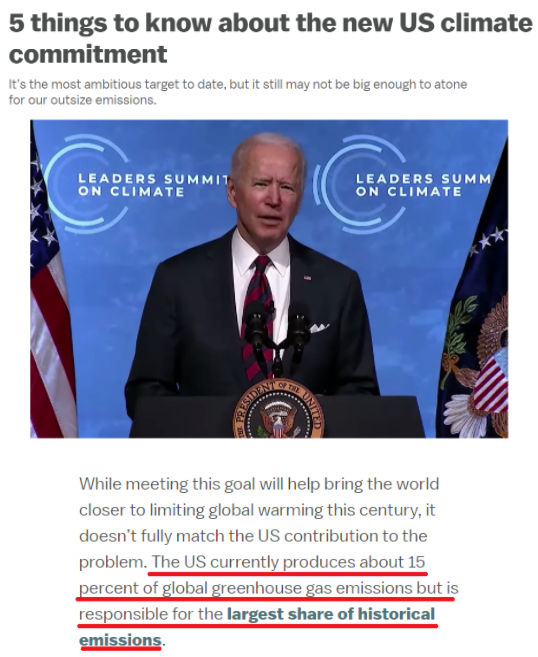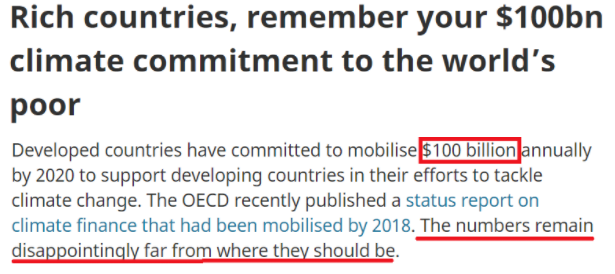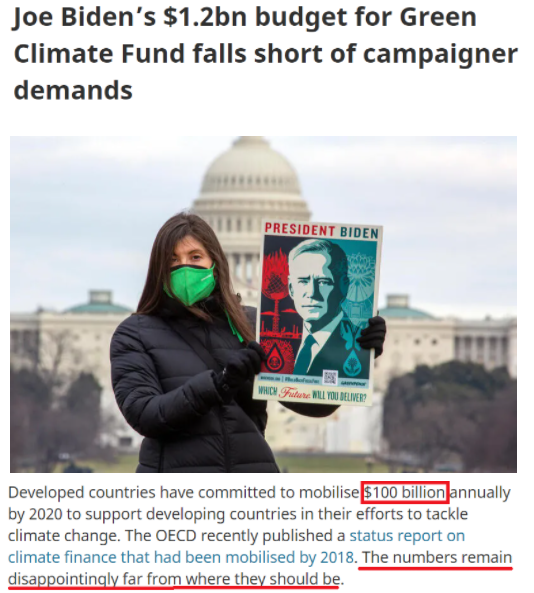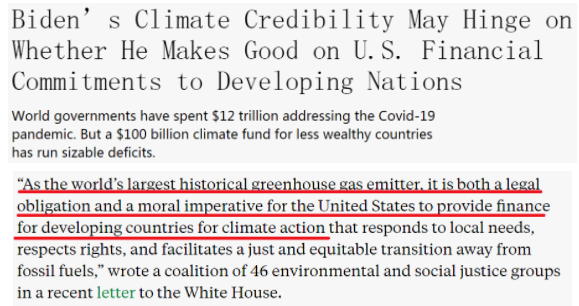At the leaders’ climate summit held a few days ago, US President Biden promised the US government’s emission reduction targets: by 2030, the US greenhouse gas emissions will be reduced by 50%-52% compared with 2005, and by 2050, the net emission will be zero.
In the past few days, Biden’s promise has become the focus of all parties. However, while the western media praised this as a "huge step forward" for the United States after the Trump administration’s retrogression for four years, they also collectively expressed their concerns and doubts about this "commitment."
Question 1: Is the promised emission reduction target reliable?
First of all, has the United States really promised its "national independent contribution"?
Some American media pointed out that climate change is a cumulative problem. The total amount of greenhouse gases emitted by the United States in history exceeds that of all other countries, and it is these emissions that help the United States become one of the richest countries in the world. Up to now, the per capita emissions of the United States are still the highest in the world, accounting for about 15% of the total global emissions.

△ US VOX News Network (VOX) report screenshot
What’s more, the United States has not yet entered the track of realizing its last "national independent contribution" commitment, let alone achieving new goals.

△ US VOX News Network (VOX) report screenshot
Second, can the United States achieve the industrial transformation necessary for these emission reduction targets?
Some western media pointed out that Biden’s commitment to reduce emissions by half in the next decade means that the US power, transportation, industry and agricultural systems need to be transformed on a large scale in a short time, but this is very difficult. "It is relatively easy to set goals, which is largely a combination of technical feasibility and political suitability. The arduous task is to complete it. "

△ Australian "Dialogue" News Network (the conversation) report screenshot
The third and most important uncertainty: whether the domestic political reality in the United States can make Biden’s commitment to reduce emissions be implemented.
As the US media said, due to the sharp opposition between the two parties in Congress, the Biden administration can only be vague about how to design its specific path to achieve new emission reduction targets. "This is a political challenge, and it remains to be seen whether Biden has enough political capital to start this process."

△ US VOX News Network (VOX) report screenshot
Michael Mann, a professor of atmospheric science at Pennsylvania State University, further believes that in the United States, it is not only difficult to turn emission reduction targets into laws, but also the consistency of government policies, because "anything done by one government through administrative actions can be reversed by the next government".

△ Screenshot of American Public Television Network (PBS)
Question 2: Can the agreed foreign aid be implemented?
According to the Cancun Agreement adopted by the United Nations Climate Conference in 2012, developed countries should provide developing countries with $100 billion in "climate financing" every year by 2020. However, according to the report on climate financing released by the OECD last year, as of 2018, these figures are still far from the level they should be.

△ Screenshot of climatechangenews report
Among them, the debt owed by the United States is particularly prominent: during the Obama administration, it promised to provide $3 billion to the "Green Climate Fund", but the actual allocation was only $1 billion. Since then, the Trump administration has directly refused to provide follow-up funds. So far, the US government still has $2 billion outstanding.
Although Biden plans to provide $1.2 billion to the Green Climate Fund in fiscal year 2022, many climate activists, including the United States, said that the money was not enough to repay the previous $2 billion debt, and the Biden administration should provide more funds to the fund.

△ Screenshot of climatechangenews report
Alex Lunfner, an activist of the "350 Africa" organization in Johannesburg, South Africa, who is committed to promoting the response to climate change, believes that $1.2 billion is "an insult to countries in the southern part of the world" and "if all the climate damage caused by the United States for many years is added up, the result should be trillions of dollars, not billions of dollars".

△ Screenshot of climatechangenews report
Brandon Wu from ActionAid USA stressed in a statement that Biden’s promised emission reduction targets and aid amount are far from enough compared with the US’s damage to the climate. As the largest emitter of greenhouse gases in history, the United States has a responsibility to the most vulnerable countries on the front line of the climate crisis.

△ Brandon Wu
A coalition of 46 environmental groups recently wrote to the White House: "As the largest emitter of greenhouse gases in history, it is both a legal obligation and a moral responsibility for the United States to provide funds for climate action in developing countries."

△ Screenshot of inside climate news report
Question 3: Is America still worth trusting?
Whether it is to implement independent emission reduction targets or fulfill foreign aid commitments, the performance of the United States in the past few years has left a deep negative impression on the world.
Can the United States be trusted? In fact, many American media have also questioned this, thinking that the debt owed by the United States in the field of climate change will not be made up by holding a summit and drawing a "pie".
Let’s look back at the "plot reversal" frequently staged by recent American governments on climate issues:
● In 1997, then President Clinton signed the Kyoto Protocol aimed at reducing greenhouse gas emissions, but the US Senate controlled by Republicans never ratified it;
● In 2001, then-President George W. Bush announced that the United States would not join the Kyoto Protocol on the grounds that the Kyoto Protocol did not stipulate the compulsory emission reduction obligations of developing countries;
● In 2015, then-President Obama signed the landmark Paris Agreement, promising to reduce US emissions by 26% to 28% compared with 2005 by 2025;
● In 2017, then President Trump announced his withdrawal from the Paris Agreement and turned to support the fossil fuel policy and the unilateralism of "US priority";
● In 2021, after taking office, Biden promised that the United States would return to the Paris Agreement … …

△ "Los Angeles Times" report screenshot
In Washington post’s view, even if Biden’s government can do a good job of political balance at home, his new commitment to reduce emissions is "just a tool to trick other major economies".

△ Washington post report screenshot
The New York Times quoted Taiya Smith, a senior researcher at the American Climate Leadership Council, as saying, "It’s hard to really trust the American government. The United States must do a lot of things before countries can restore their confidence in it. The United States must prove that this is not a temporary political interest. "

△ The New York Times report screenshot
The article in Australia’s "Dialogue" news network believes that the Trump administration’s destruction of global efforts to deal with climate change in the past four years has seriously weakened the credibility of the United States overseas. In view of this, although the White House’s new commitment is bold, "adjectives are still long and credible verbs are still short". It remains to be seen whether this commitment will help convince the world of the United States.

△ Australian "Dialogue" News Network (the conversation) report screenshot
Planning Wang Jian
Written by Shan Lijuan
Editor Lin Wei Weng Hai New Li Haixia
Qian Shen Hou Chen Wang Jian
Producer Guan Juanjuan
关于作者